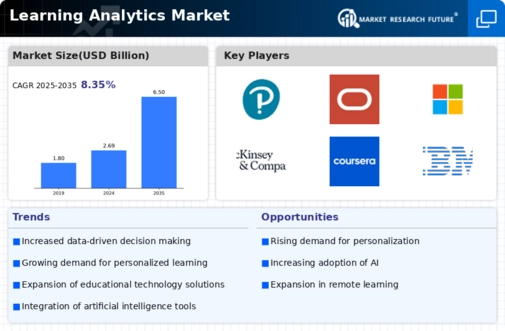Top Industry Leaders in the Learning Analytics Market

Competitive Landscape of the Learning Analytics Market
The learning analytics market, experiencing a meteoric rise fueled by the digital transformation in education, is a vibrant arena where established giants and nimble newcomers battle for dominance. Understanding the competitive landscape is crucial for any player in this dynamic space. Let's delve deeper into the key players, strategies, factors driving market share, and emerging trends.
Key Players:
- IBM (US)
- TIBCO (US)
- D2L (Canada)
- Microsoft (US)
- Ellucian (US)
- Hobsons (US)
- Oracle (US)
- Civitas Learning (US)
- Zogo Technologies LLC (US)
- SAP (Germany)
- InetSoft (US)
- SAS Institute (US)
- Tableau Software (US)
- Certica Solutions (US)
- MicroStrategy (US)
Strategies Adopted:
- Product Differentiation: Players are constantly innovating, offering specialized solutions for K-12, higher education, corporate training, and other segments. Integration with existing learning management systems and focus on data security are crucial differentiators.
- Partnerships and Acquisitions: Strategic partnerships with educational institutions, data providers, and technology companies are common. Acquisitions of smaller companies with niche expertise are also a key strategy for expanding market reach and acquiring new capabilities.
- Cloud-based Solutions: The shift towards cloud-based learning analytics platforms is gaining momentum, offering scalability, cost-effectiveness, and ease of access. Players are increasingly focusing on secure cloud solutions to address data privacy concerns.
Factors for Market Share Analysis:
- Revenue and Market Share: Revenue figures and market share estimates are the most commonly used metrics, but they need careful interpretation due to the fragmented nature of the market.
- Customer Base and Verticals Served: Understanding the type of institutions and educational segments a player caters to provides insights into their strengths and potential growth areas.
- Solution Portfolio and Features: Analyzing the breadth and depth of a player's solution portfolio, along with unique features and functionalities, helps assess their competitive edge.
- Technology Stack and Innovation: The underlying technology stack, data analytics capabilities, and commitment to innovation are crucial factors for future success.
New and Emerging Companies:
The learning analytics market is constantly evolving, with new players emerging with innovative solutions. Some key trends to watch include:
- AI-powered Learning Platforms: AI-powered platforms that personalize learning paths and offer adaptive learning experiences are gaining traction.
- Predictive Analytics and Early Intervention: Solutions that predict student success, identify at-risk students, and enable early intervention are becoming increasingly sought-after.
- Micro-credentials and Competency-based Learning: Analytics tools that track progress and skill acquisition for micro-credentials and competency-based learning are gaining importance.
Current Company Investment Trends:
- Focus on Data Privacy and Security: Companies are investing heavily in robust data security measures to address privacy concerns and comply with regulations.
- Integration with Learning Management Systems: Seamless integration with existing learning management systems is crucial for wider adoption and data accessibility.
- Advanced Analytics and Visualization Tools: Players are investing in developing advanced analytics capabilities and user-friendly visualization tools for deeper insights and improved decision-making.
Latest Company Updates:
The analytics that a business LMS may offer should be taken into account when maximising its potential. Each interaction, click, score, and minute of time documented provides a priceless piece of information. It offers a thorough examination of how staff members interact with training materials, enabling a deeper comprehension of their pedagogical practises and degrees of engagement.
But it's not as simple as it seems to make sense of all this data. Finding the most useful information depending on the unique training goals and objectives of your company is the secret. These might centre on promoting the application of taught abilities in the workplace, boosting team member engagement, or enhancing knowledge retention.
An efficient way to improve training results is to use data-driven analytics from a corporate LMS.

